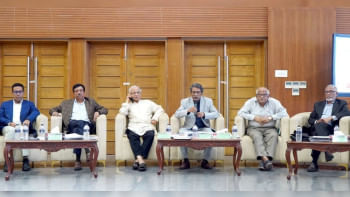A MILLENNIUM OLD DISCOURSE
Bangla -- the language of a million, a language that has shaped the culture of millions; a language that influences literature through stalwarts like Tagore, Nazrul and Jibanananda, a language that sets the ethos of a people who seek their social, and to a greater extent, political identity in a common parlance.

This is Bangla, thought to be a member of the Indo-European language family, with its birth taken from a specific form of 'Prakrit' (a spoken language) sometime around the tenth century A.D.
Its script is thought to have stemmed from the Brahmi alphabet, one of the two ancient Indian scripts; the other being Devanagari. However, Bengali took a divergent line away from the Devanagari and the Oriyan scripts, although it bears some resemblance to the Assamese alphabet.
Linguists agree that once in the distant past, Oriya, Assamese and Bengali had a common origin, from which the Oriya and later Assamese severed off. This is the primary reason why speakers of Oriya and Assamese also claim their right over the 'Charyapadas' (Buddhist mystic songs) as the earliest specimen of their language.
The 'Charyapada' is a collection of 8th–12th century mystical poems that were intended to be sung. These hymns of realisation were spontaneously composed verses that expressed a practitioner's experience of the enlightened state. According to Bengali scholar Haraprasad Shastri (1853–1931), 'Charyapada' is also the collection of the oldest verses written in pre-modern Bengali.
By the twelfth century, the alphabet of Bengali had evolved, with natural inclusions and exclusions continuing till the sixteenth century. Some conscious alterations were also made in the 19th century, notably by the Bengali Academy.
The richness of the Bengali tongue is observed, not only in its script, but also in its grammar. The Bengali grammar is different from that of Hindi and most other Indian languages as the Bengali nouns are not assigned gender; the verbs also do not change in accordance with the noun. There is also minimal changing of adjectives in the language.
The history of the Bengali language has been divided into three eras -- Old Bengali (950-1350 AD), Middle Bengali (1350-1800) and Modern Bengali (1800 to the present day).
Little is known about the Old Bengali period, from which only a collection of forty-eight poems, the Charyapadas (1050-1200), survive. In comparison Middle Bengali covers a huge period. The 15th century is highlighted with literature forms, a genre mainly of narrative poetry rich in its religious content. The century that followed presented itself with a shift to spiritual ideologies, albeit adhering to the narrative poems that now took the form of epics.
The 17th century saw the emergence of romantic verse, tales that were written solely by Muslims. Even the Muslims of Arrakan, who had close intellectual contact with Bengal, were active in literary pursuits in Bengali.
The literary renaissance in Bengal took place at the hands of Michael Madhusudan Datta (1834-1873) and Bankim Chandra Chatterjee (1838-1898) who were the founders of the modern age in Bengali literature.
Madhusudan was the first Bengali poet to write in blank verse and was in a quest to combine western influences into the essence of Indian literature. His Meghnadvadhkavya (1861) written in blank verse has the same flavour as Milton's Paradise Lost. There Madhusudan treated Meghnad, one of the villains of Ramayana, in the same human angle as Milton portrays Satan, a complete departure from the traditional approach.
The first truly romantic Bengali novel is Bankim Chandra's Durgeshnandini (1865), while the first Bengali novel of social realism is Peary Chand Mitra's Alaler Gharer Dulal (1858).
Rabindranath Tagore himself gave a new meaning to Bengali literature. Tagore was a poet, novelist, short-story writer, dramatist, essayist and literary critic all rolled into one. No other Bengali had written at such length and breadth of a language and age. He was the first Indian to receive a Nobel Prize.
The modern age begins with a group of writers who wrote for Kallol, a modernist movement magazine founded in 1923. The most popular among the group was Kazi Nazrul Islam, our national poet.
A walk around the Ekushey book fair takes us through a journey filled with emotions that satiates our senses and gives us a sense of pride in the thousand-year journey of Bengali literature. From the Charyapadas to the latest fiction by Zafar Iqbal or Anisul Haque, the Bengali creed has enough reasons to boast a language, a source of pride that we call Bangla.
Source: www.britannica.com


 For all latest news, follow The Daily Star's Google News channel.
For all latest news, follow The Daily Star's Google News channel. 



Comments